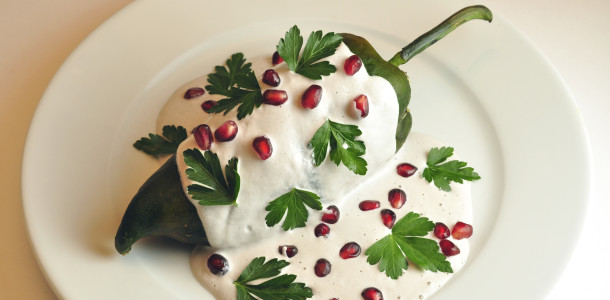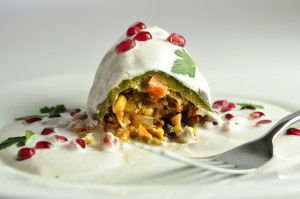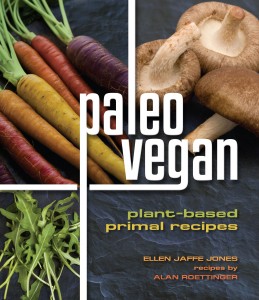Living in Mexico from age two to twenty-one, I enjoyed chiles rellenos many times, with both meat and cheese fillings. Because my parents wouldn’t eat Mexican food, despite living and traveling extensively through out the country for many years (go figure), as a child I had to sneak into the kitchen when the maids were eating their own food if I wanted to have a taste. I liked the gringo food they made for us well enough, but it was so pale and predictable compared with the exotic explosion of flavor, color and texture I experienced with Mexican food. When we went out to eat at restaurants, my sisters and I would always choose Mexican dishes—the more exotic the better—while my parents tucked into their plain hamburgers, spaghetti and grilled cheese sandwiches. We ate at restaurants all over Mexico, and yet, oddly enough, I never once came across what is now a permanent favorite: chiles rellenos en nogada (stuffed chiles in walnut sauce). I can only surmise that my parents’ choices of eateries factored into this heinously narrow exposure to one of the world’s most regionally varied and sophisticated cuisines.
This dish was created to commemorate the defeat of the French by General Ignacio Zaragoza’s Mexican forces in the Battle of Puebla on the 5th of May (“cinco de mayo“), 1862. It was significant at the time, because the invading French army was well-trained, well-equipped, and much greater in number—and yet the Mexican militia stopped them (Viva México!). Ultimately, the French prevailed, conquering Mexico and installing a cousin of Napoleon III, the Austrian Archduke Maximilian, as “emperor.” Nevertheless, the Battle of Puebla was a huge source of pride for Mexicans, and the Cinco de Mayo became a regional holiday. Maximilian’s reign was short, ending before a firing squad, and although few Americans have ever heard of him, most are at least vaguely familiar with the Cinco de Mayo as a Mexican holiday.
Chiles Rellenos en Nogada are now served most prominently on Independence Day, September 16th, owing solely, I strongly suspect, to the green, white and red colors of the Mexican flag represented in the dish. It’s one of Mexican cuisine’s most stunning and delicious dishes, featuring well over 40 ingredients, including four kinds of meat and nine fresh and dried fruits. It’s also quite painstaking, if you’re making it for a large party (as is usually the case). Like making mole poblano, it involves several steps, and at least one of them is labor intensive: peeling the walnuts. But like most celebratory dishes, it’s well worth the effort and appreciated by all.
Since I no longer eat meat, or eggs, or cream or cheese, and rarely fry anything, much less in lard, I’ve had to monkey with the recipe to great extent. I must admit my new version lacks the depth and serious umami of the original, but what it leaves desired in authenticity it makes up for in, well, edibility (by me). It’s also a little less work (no egg-battering and frying), and far more health-friendly. You can do this!
Chiles Rellenos en Nogada
Serves 6
For the sauce:
2 cups walnut halves
3/4 cup cashews
1 thick slice stale bread, crust removed
1 1/2 cups Almond Kefir*
1/2 cup finely diced white onion
3/4 teaspoon unrefined sea salt
1/3 cup unsweetened almond milk
3 tablespoons dry sherry
1 or 2 tablespoons freshly squeezed lime juice
1 pinch or 2 ground cinnamon
For the filling:
2 ears white corn
2 tablespoons extra virgin olive oil
1 cup diced white onion1 cup diced celery
1 cup diced carrot
1 cup diced jicama
1 cup diced calabacita, or zucchini
1 cup diced roasted red pepper
1 small potato, peeled and diced
7 cloves garlic, minced
2 serrano chiles, finely diced
1 1/2 teaspoons unrefined sea salt
3 roma tomatoes
2 tablespoons chipotle puree
1 tablespoon ground Chimayo chile
pinch ground cloves
pinch ground nutmeg
1 sprig thyme
1 sprig marjoram (optional)
2 bay leaves
Freshly ground black pepper
6 poblano chiles
For plating:
1 cup pomegranate seeds
1/4 cup parsley leaves
Prepare the sauce: In separate bowls, soak the walnuts and cashews in plenty of water to cover for 8 to 12 hours. Peel the skins from the walnuts, using the tip of a paring knife, as needed to loosen them. Rinse and drain well. Rinse and drain the cashews.
Put the nuts in a blender and add all the remaining ingredients, including 1 tablespoon of the lime juice. Process until smooth. Taste and add more lime juice or cinnamon, if needed.
Prepare the filling: Preheat a grill on high. Shuck the corn and set them on the grill. Cook, turning as needed to blacken the tops of the kernels evenly. Wrap the corn tightly in foil, and set aside to continue cooking in the residual heat.
Put the olive oil in a large pot over medium-high heat and add the onion. Cook, stirring often, until soft and just beginning to color lightly, about 5 minutes. Add the celery, carrot, jicama, zucchini and red pepper, and stir well. Continue cooking, stirring frequently, until the vegetables begin to soften, about 5 minutes. Add the potato, garlic, serranos and salt, and stir constantly until the potatoes begin to stick, about 3 or 4 minutes. Put the tomatoes, chipotle puree, Chimayo chile, ground clove and nutmeg in a blender and process to a puree. Add to the pot and stir well. Add the thyme, optional marjoram and bay leaves and stir. Decrease the heat to medium-low, cover the pot, and cook until the vegetables are tender, about 15 minutes. Unwrap the corn and cut the kernels off the cobs directly into the pot. Stir and cook, uncovered, an additional 5 to 10 minutes, until the liquid has reduced to a thick sauce. Taste and adjust seasoning with salt and pepper, as needed. Set aside to cool.
Prepare the chiles: Set the chiles over an open flame and roast, turning as needed, until evenly blackened. Place the chiles in a bowl, cover tightly, and allow them to steam in the residual heat for 10 minutes. Pour cold water into the bowl to loosen the skins. Peel the chiles. Cut a slit in one side of each chile. Carefully pull out and discard the seeds and membranes. Stuff the chiles with the filling, pressing firmly to pack as much in as possible.Set the chiles in a steamer basket and steam for about 5 minutes, until warmed through. Alternatively (if you don’t have a steamer, or if it is too small to hold all the chiles), set the chiles in a large pan, cut side down, and pour in about 1/4 cup water. Cover and set over a medium heat until the water has been absorbed and the chiles are hot.
To serve: Set one chile on each plate, cut side down. Spoon the sauce over them, allowing it to slide down both sides onto the plate. Garnish with the parsley leaves and pomegranate seeds, and serve at once.
Now, to get you in the proper mood:
*As of this writing, no almond kefir or yoghurt is available commercially, so you have two options. You can use your favorite nondairy yoghurt or sour cream, or you can make your own almond kefir. I recommend making your own almond milk for this, as commercial milks are too thin for best results, and contain some potentially undesirable ingredients (like carrageenan). I use 2 cups almonds to 4 cups water for what I call “rich almond milk.” Just soak the almonds for 8 to 12 hours, drain and rinse them, and then put them in a blender with the water and process until smooth. Then pour the mixture through a nutmilk bag and squeeze until no more liquid is released.
Use a kefir starter, following the directions on the packaging.











